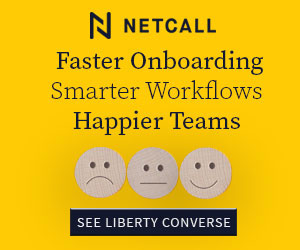Ilya Filipov at Talkdesk analyses three ways AI can help insurers weave empathy into the fabric of their enterprises.
Empathy isn’t a word consumers typically associate with insurance companies. But that doesn’t mean empathy isn’t important to policyholders. Quite the opposite: Empathy demonstrated by insurers can have a profoundly positive effect on overall customer satisfaction and brand loyalty.
Whether filing a claim involving a house fire or facing a stressful decision about which life insurance option to choose, consumers can display a range of emotions – from anxiety to shock – when interacting with their insurers.
They may be in a fragile state that makes it difficult for them to answer questions or make decisions. This is when insurers must be able to empathize, both in how customer-facing representatives interact with policyholders and in how easy insurers make it for policyholders to navigate the claims and service requests.
It may sound counterintuitive, but artificial intelligence (AI) can be used by insurers to spread empathy across the entire organization. Here are three specific ways AI can help insurers weave empathy into the fabric of their enterprises.
Define What Empathy Means in Your Organization.
Ask 10 insurers what empathy means to them, and you’re likely to get 10 different answers. However defined, empathy for insurers is hard to convey convincingly while they are denying a claim.
Yet every insurance company can readily identify those “top agents” able to deliver any message to a policyholder in an empathetic way, agents who possess a special ability to communicate with customers on a human level.
The first step for insurers in building an empathetic organization, then, is to analyze what these successful agents – the top 5%, for example – are doing and compile a list of empathy best practices that can be used to train all agents.
However, these top-performing agents on the empathy scale are far more intrinsically skilled and not easily emulated. It is critical, therefore, that insurers bring in experienced coaches and consultants to build effective training and response programs.
Compounding the organizational empathy challenge for insurers is the trend toward providing self-service both to increase efficiency and meet rising customer expectations for convenience.
Granted, policyholders don’t have a need for empathy in every situation, but when they do, they are not going to get it from an AI-based chatbot.
Use AI to Build an Empathy Model.
The limitations of chatbot technology notwithstanding, AI can play an integral role in raising an organization’s empathy level by acting as a real-time coach for live agents, offering proposed responses and specific language to convey empathy to policyholders. In this context, AI acts as a skillful hidden hand guiding the human touch.
With input from management, data scientists, and experience from their top empathy performers, insurers should utilize AI to program or create an empathy model for other agents to follow. This is the second step insurers should take to build an organization that is consistently empathetic to policyholders.
Imbue Empathy Across the Enterprise.
The third step is to implement the AI empathy model so that it is part of every conversation with customers.
An AI model can generate suggestions in real time along with information and feedback that managers can use to coach their teams and institute a practice in a way that better conveys empathy during customer conversations.
As an example, insurers can use AI and natural language processing (NLP) to conduct sentiment analysis in real time to gauge the emotions of a policyholder speaking to an agent.
The AI model uses this information to suggest responses and specific language to human agents while they’re interacting with the customer. The sentiment analysis score then can be viewed by supervisors to gauge areas of improvement for the agent.
There is no doubt that some people have a gift for interacting with others and for expressing empathy. And though you can’t teach gifts, you can teach skills. With the right tools and training approach, human agents can upgrade their empathy skills enough to improve their effectiveness and overall performance.
Not everyone is going to be in the top 5%, but if insurers can upgrade someone from the top 40% to the top 20%, and replicate that process through the AI model, that’s a big win.
Conclusion.
In the wake of the COVID-19 pandemic and as natural disasters continue to increase, empathy has become more important than ever for policyholders and, by extension, insurers. When a policyholder is in crisis, after all, he or she wants to talk with a fellow human.
Thus, while the benefits of AI, automation and self-service to insurers and policyholders are many, it would be a mistake for an insurance company to rely strictly on these technologies for customer support.
The most effective approach is a hybrid human/AI model that can be customized to fit the specific needs of the organization.
This post was first published at Advisor Magazine.
This blog post has been re-published by kind permission of Talkdesk – View the Original Article
For more information about Talkdesk - visit the Talkdesk Website
Call Centre Helper is not responsible for the content of these guest blog posts. The opinions expressed in this article are those of the author, and do not necessarily reflect those of Call Centre Helper.
Author: Talkdesk
Published On: 11th Mar 2022 - Last modified: 15th Mar 2022
Read more about - Guest Blogs, Talkdesk






 Talkdesk is a global customer experience leader for customer-obsessed companies. Our contact center solution provides a better way for businesses and customers to engage with one another.
Talkdesk is a global customer experience leader for customer-obsessed companies. Our contact center solution provides a better way for businesses and customers to engage with one another. 


































